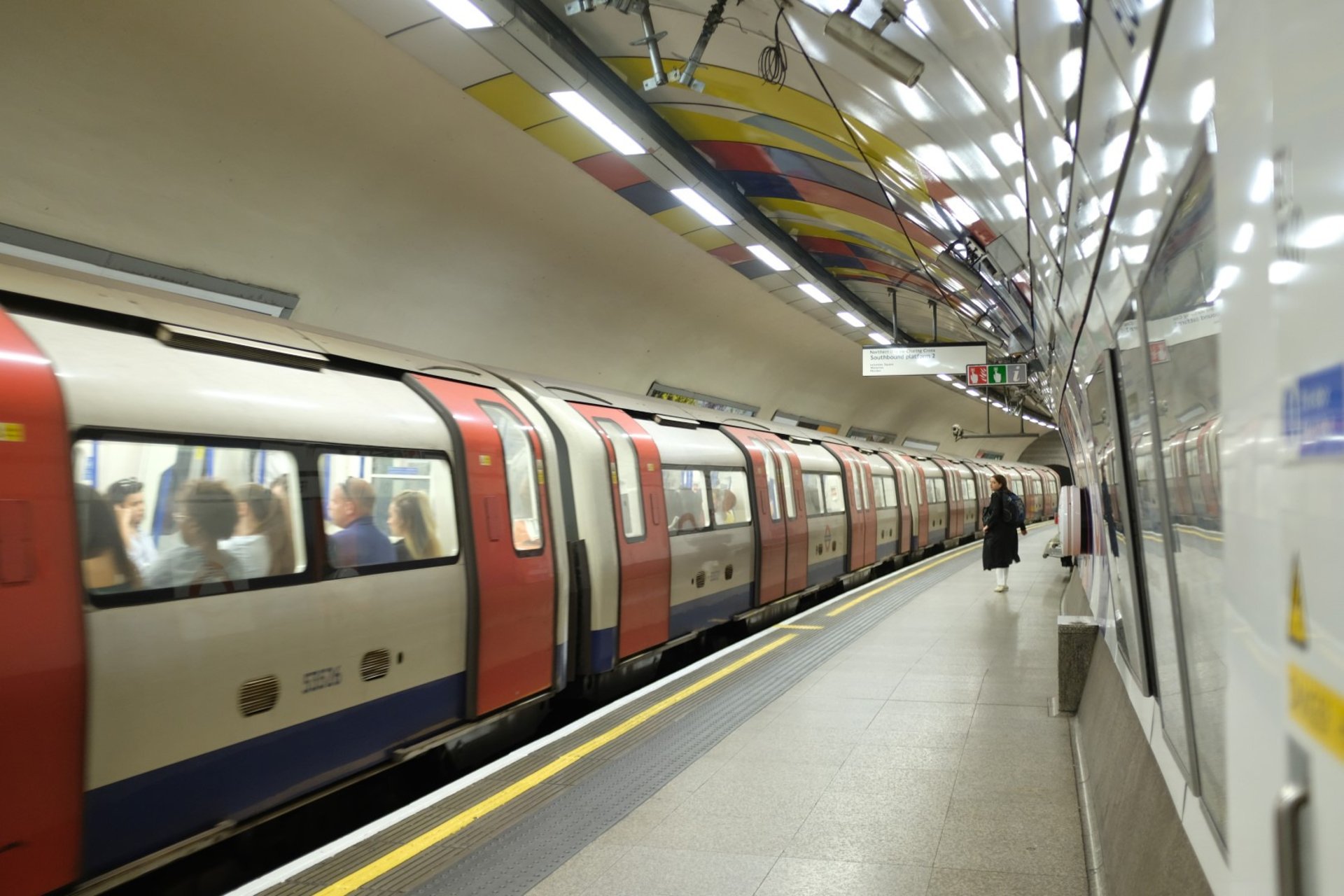
Something to make you change your mind
2018, London, England, The British Museum
UNITED KINGDOMEUROPEMUSEUMS
Across the pond
London is only an hour and a half in a Ryanair cabin from Ireland, but the first time I deigned to pay a visit was already a few years after travelling to the ends of the Earth in places like Nepal and Peru. To be honest, for a long time I thought England would be much the same as home but with a bigger ego, and I wanted to see the world. Of course, as a result I remained ignorant that the world could actually be found right there, living in London.
That first time seven years ago I went over with my cousin to visit my sister, who was studying there at the time. She was staying in the little town of Wivenhoe, and so we made forays from there into the city centre to see Big Ben, the Eye, Madame Tussauds. A few bright memories stand out; the banter with an English taxi driver, the best fish and chips of my life, proper lip-smacking English ale, a dog asleep in the pub. For the most part though it was a time to spend with family, and London a backdrop. This summer things lined up to bring me back. I still had some of that scepticism about travelling in the UK and so it was all prompted again by someone else, a certain special anglophile. We talked about a grand tour of England, and my eyes started to open to how much there was to see and do. The way the chips fell in the end, that itinerary wasn't to be. Nonetheless I would make a stop in London before continuing on, in a Ryanair cabin, for a visit home to Ireland.
I got in to Gatwick early on a Sunday morning. There are a few ways to get to the city centre from this airport, including bus and rail links. I went with the Gatwick Express, which is a good balance for price, time and comfort. I highly recommend picking up an Oyster card before boarding any transport in London, as the savings are going to be significant even on a short visit of a few days. The Gatwick Express took me directly to Victoria station, from where I could switch to the London Underground, affectionately known as the "Tube". The nickname clicks as soon as you enter the web of narrow tunnels which somehow still accommodate the city's millions as they get from A to B. In the airy modern metro systems I've gotten used to in cities like Budapest and Saint Petersburg, you can almost forget you're underground at all, but in the Tube the walls seem to hug you, and little tunnels channel travellers from left and right in a way that brings a rabbit's warren to mind. This felt quaint to me at first, but it makes sense when you consider that London's system was a world first. The Tube's original architects were planning for a nineteenth century population and a very different kind of locomotive, and they had no precedent to take as a model. As well as still being a very efficient way to get around, I thought the Tube was a sight in itself. Something about the lego brick colours, the whooshing pneumatic doors and all the prompt little toings and froings made me think of Doctor Who. It's also a crash course on the denizens of this metropolis of a city, with every shape and size, colour and creed of human being you can imagine bustling past you. Over the course of my short stay in London, the Tube treated me to such anecdotes as a sharply dressed, apparently Italian man lost in a loud debate with himself about the pros and cons of the humid weather, a Muslim woman in full niqab sharing a square metre with a drag queen in full make-up, and a Hungarian chatting in his native language after seemingly – because London – having just inhaled helium.
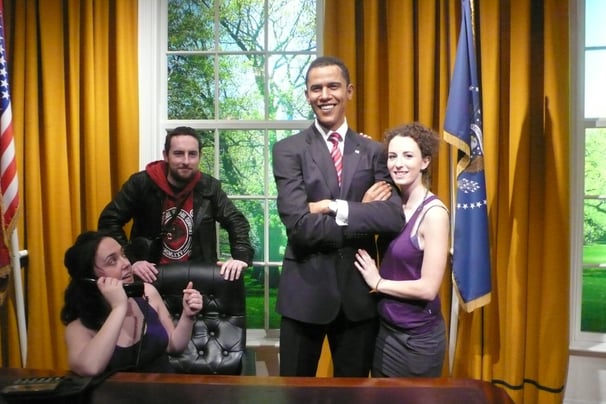

Obligatory Madame Tussauds group shot, 2011
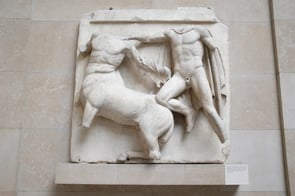
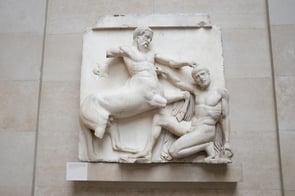
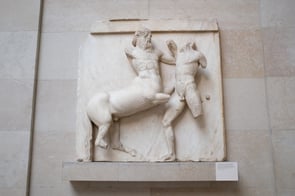
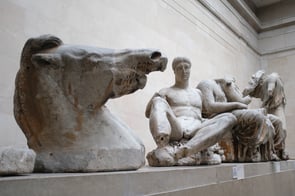




As you enter the British Museum you step back in time in more ways than one. Here are the ethnographic highlights of the whole world, and the custodian is the old Britain of Empire, unquestionably a harbinger of domination and exploitation as well as one of history's greatest movers and shakers, an opener and a connector by hook or by crook. First London conquered the world, but now that the world has returned to conquer London, there's an awkwardness to the treasure trove on display here. One example is the collection of artefacts from the kingdom of Benin, once located in what is now Nigeria. This is an amazing exhibition of sculptures and plaques in bronze, wood and ivory that give a glimpse into a culture that I knew nothing about. Benin was an advanced society with a unique artistic tradition and complex urban centres, in particular its capital, Edo. When you learn that the pleasure of seeing these artefacts is owed to the burning and looting of that city at the turn of the twentieth century, it does leave a bitter taste in your mouth. History is history you might say, but Nigeria has been requesting the return of these artefacts since its independence over fifty years ago. Much better known in this thread is the case of the "Elgin" marbles, so named for Thomas Bruce, seventh Earl of Elgin, who took them from the Parthenon in Athens and eventually sold them to the British government. At the time Greece was under the Ottoman Empire, from whom Elgin claimed to have received permission. This is itself disputed by historians, even if we put aside the lack of consideration given to Greece and Greeks, then and now. It makes me think of an old German flatmate and his collection of pint glasses lifted from pubs in the four corners of Cork city. "And where did you rob that one, Conrad?". "I didn't rob it. I got it". The British Museum's defence is a bit more developed than that, to be fair. It's argued that the marbles, like the Benin bronzes, are the heritage of all mankind and as such it's better to keep them in a global city like London where they can most easily be enjoyed by the greatest number of people. It's not an empty argument, but ultimately I don't think it's a strong one. I wouldn't go so far as to say everything should be kept in its country of origin – nobody is – and in fact I'm a bit wary of getting too bogged down in who owns what. There's huge educational value in being able to show cultural objects from abroad, and treating these items as global heritage makes sense and avoids projecting simplistic divisions onto the past. Still though, when it's the most special examples, the real treasures of another land, it doesn't seem reasonable or fair to hoard them hundreds or thousands of kilometres from where they were first imagined and made real. Athens has an excellent museum ready to welcome its missing marbles back, and the ease of access argument for the heritage of Benin crumbles fairly quickly when you consider that West African people are being expected to travel to another continent in order to see the heritage of their own region. The Museum isn't unaware of the criticism and has recently launched the Collected Histories talks, aimed at showing the nuances in how its collection came to be. Of course, it wasn't all pillage and looting, but some of it was, and I'm afraid that point is still being side-stepped.
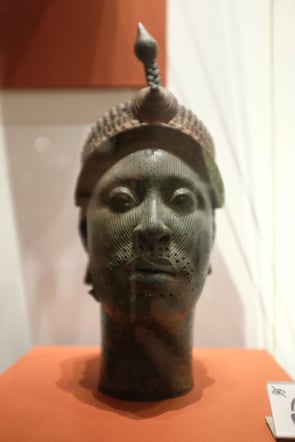
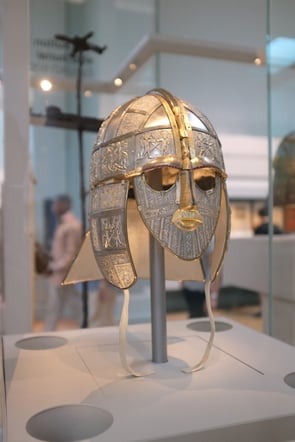


Day 1: The British Museum
Just as London more or less defined what an underground is, the same might be argued when it comes to museums. The British Museum is rightly famous the world over, and it was my priority for the first day. First from Victoria station I took the Tube to Islington and checked in to my accommodation, a private room in a house on a quiet street that I'd found through Airbnb. From there I decided to take the half hour stroll to the museum, along the way taking in the sights of the borough. I think an English friend of mine put it well when he said the city's subdivisions feel a lot like individual towns, each with their own character. Here and there I think there are even little nooks with the feel of somewhere far away from the capital. One example for me was Regent's Canal, with its leafy promenades and floating homes complete with placid barge folk.
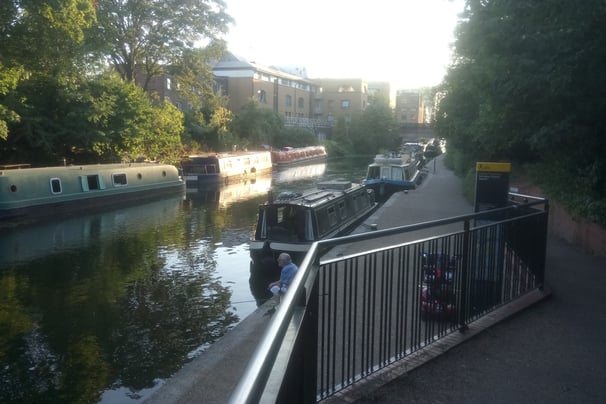

Regent's Canal - rural vibes inside the city
Not far from the museum I came across a kiosk manned by two activists, a man and a woman, both trying to withdraw from an engagement with an animated passerby so they could have their lunch. The European blue and yellow was flying over them, and the passerby, actually who was doing the opposite of passing by, was pleading with the woman and everyone around him to accept that the European Commission was completely undemocratic. I glided over and struck up a conversation with an Australian local on the borders of the debate, and we took turns agreeing that the whole thing was a mess. Somewhat disappointingly, in the meantime the Brexiteer gave up and went on his way.
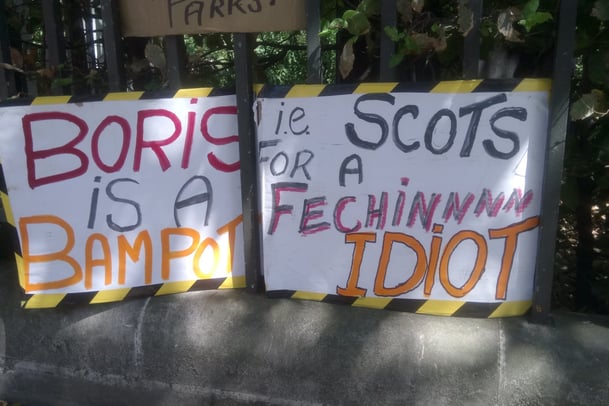

Political snapshot
Do take your time though. The Parthenon ("Elgin") marbles are a great example of something you could easily zip past without properly taking in. If you slow down and just look for a while, it all starts to sink in. Panel after panel and statue after statue, all were cut from real marble by real hands a very long time ago, and the story and drama cleverly packed into each one of them will humble anything an artist has done before or since. I really enjoyed the metopes, which are marble panels that used to decorate the space between the columns and the roof of the Parthenon in Athens. Each one shows an action scene, and they add up to tell a different story for each of the four sides of the building. On the west side there were scenes from fights with the Amazons, the north had the fall of Troy, the east had clashes with giants, and probably my favourite was to the south; the brawl between the Centaurs and the human Lapiths. A bit like a comic book, you see the men and monsters locked in combat, sometimes one side and sometimes the other getting the upper hand with an arm grabbing at the scruff of a neck or lunging in for a punch. Often there's more than one thing happening at once. In one metope a Lapith has been knocked back onto the ground and a Centaur is bearing down on him, but with one hand he reaches back to grab a rock to counter-attack. It's humanity's greatest hits, and I left the museum with a feeling of warm gratefulness poured on top of that cooler layer of objection.
Moving on from these unfortunate matters of fact, for the sheer range and depth of its exhibitions the British Museum is hard to beat. Every corner of the world and every period of history is represented. There must be very few other museums in the world, maybe none, where you can see so much, and entry is free. As well as the two collections I've mentioned above, I was excited to see the famous Rosetta stone. Discovered by Napoleon's armies in Egypt, then seized by the British, it was ultimately used by Egyptologists to decode the ancient hieroglyphic writing system. Yes you guessed it, Egypt would like it back. Another highlight for me was the Sutton Hoo helmet, the iconic Anglo-Saxon hard hat and face mask. No disputes here, this one is England's own. The layout of the museum is also innovative with a circular courtyard at the centre, itself holding some impressive Native American totem poles under its high ceiling. You can use this space as a kind of roundabout as you move between the different wings. As with any big museum, come early to beat the crowds and expect traffic jams for the Egyptian collection and other standouts.
The Bronze Head from Ife, The Sutton Hoo hemet
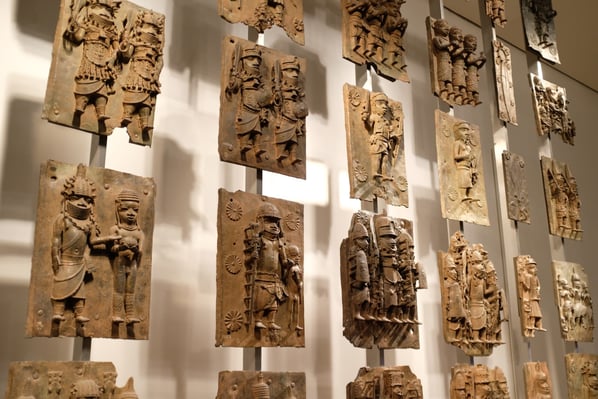

The Benin Bronzes
The Parthenon Marbles
For my second day I wanted to get outside, and started off by Westminster Bridge. Big Ben was decked out in scaffolding for renovation, but the sun was shining and the air was warm along the Thames. I paid a visit to Boudica, Queen of the Celtic Britons, and the monument to the airmen of the Battle of Britain. Both I suppose in part are symbols of this island country's stiff resistance to any interlopers from the continent, a narrative from history that echoes loudly in today's headlines. I met with that “certain special anglophile” back at the bridge, Irina, my ex-girlfriend from Russia. We had actually planned to travel around England that summer together, but had broken up before anything beyond London was booked. We were still friendly though, and before she would continue on with her own itinerary, we agreed to spend a day out in London together. From the river we walked to Buckingham Palace, where it was too late to see the Changing of the Guard, but we poked our heads in through the railings anyway. We walked on up to Hyde Park and forgot we were in a city for a while. Following the curve of the Serpentine lake through leaves and chestnuts, past joggers and deck chairs, we stopped and drank wine. At the Albert memorial we boggled at Queen Victoria's gushing tribute to her husband, flanked by statues depicting Britain's former subjects from the four corners of the Earth. We continued over to the Natural History Museum, and spent a couple of hours taking in geology's surprises in colour and form, and experimenting with the interactive displays. We rounded off a perfect day with fish and chips and then a can of IPA in the soft air outside Victoria station, where we said goodbye. What will stay with me brightest though is the blazing sunset we caught together before we left Hyde Park, easing down calm and brilliant over the lake while the rest of the city sped on at the same tempo, never missing a beat.
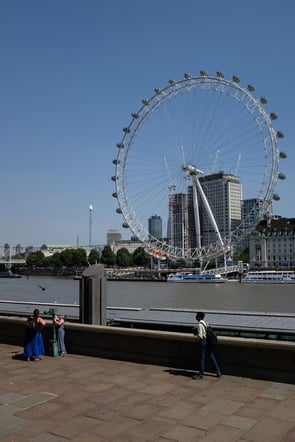
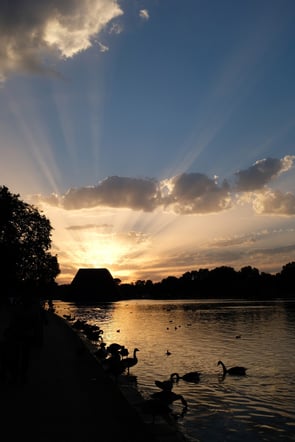


Day 2: Walkabout from Westminster Bridge to Hyde Park
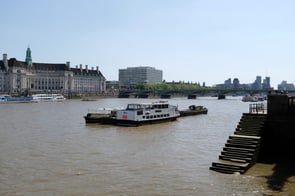
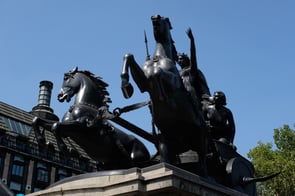


View of the Thames, Statue of Queen Boudicca
London Eye, Sunset in Hyde Park
For my third day I met up with an old friend Julie, (all right, also an ex-girlfriend), who had moved to London a year previously for study. We met up at Piccadilly Circus and took a stroll through Chinatown before having lunch at her university campus. We shared our struggles as humanities graduates, and agreed that though the engineers and scientists of the world might answer how, it's for the artists and philosophers to ask why. Via these kinds of conversations we made our way to Sky Garden. This rooftop greenhouse bar and restaurant is a great alternative to the Shard. Entry is free, though you need to reserve tickets on their website (up for grabs about a week in advance). The air is fresh with all the plants and the view over the city is excellent. We enjoyed it with cocktails and beer.
Day 3: Picadilly Circus, Sky Garden, Brick Lane
For dinner in the evening Julie took me to Brick Lane in the borough of Tower Hamlets, filling me in on its history along the way. As can be seen in its bilingual street signs, this area was an early destination for Bengali immigrants, and many other nationalities have followed in their wake. We had our pick of curry houses, but went with a place called Aladin where we ate well for a reasonable price. Later over a few beers back at her flat she introduced me to her flatmate, an Albanian chef and polyglot who was having the whole family over to visit, halfway into cooking up a traditional dinner. We said goodbye several times in the stairwell, and I was on the overground back towards my room.
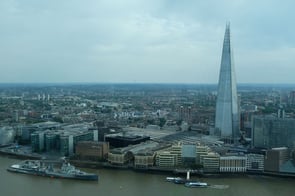
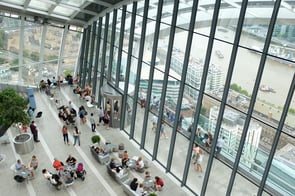
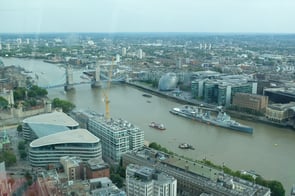
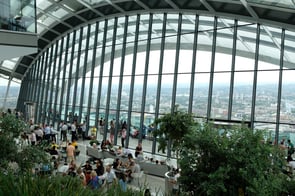




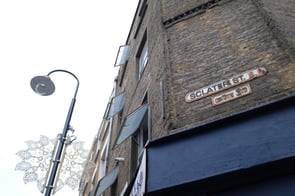
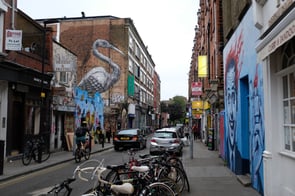


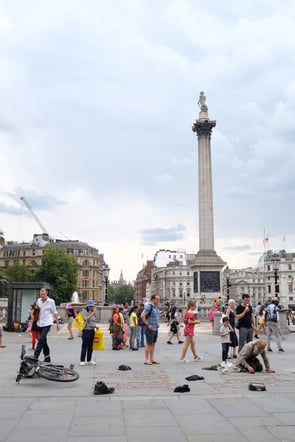
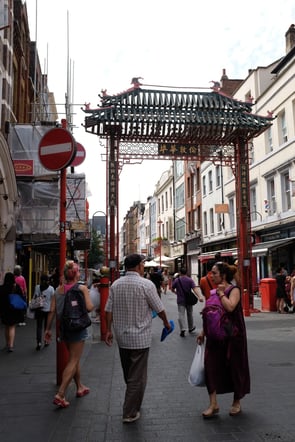


Trafalgar Square, Chinatown (both near Picadilly Circus)
Airbnb, a cautionary tale
It was around midnight when I rounded the corner onto my street. As I approached the house something made me cock an eyebrow. It was one of the owner's cats, sitting nervously outside the gate. She watched me for a moment, then scampered towards me meowing anxiously. I knelt down and gave her a sympathetic stroke. The cats weren't allowed out of the house, I remembered. I went to the gate, finding it open, and there thrown on the ground there was... a pair of shoes. The front door was closed, but above it the window of the master bedroom was open with the curtains billowing and a low light glowing. Somehow it was only then that I heard the shouting match going on inside. I double-checked the address in my phone as the argument escalated. There seemed to be one man having an absolute conniption and another man and a woman yelling at him. I shifted through the scenarios in my mind, discounting the possibility that it was a break-in based on what they were saying to each other, reconfirming that I had the right address, concluding that there was some kind of domestic happening between another group of guests (the host was renting out rooms individually). The woman shouted a racist slur at the man, making me flinch. Was that the host? As far as I knew, she was out of town, it was her son that had passed me the keys earlier. Just as it was sounding like things would get physical, the second man shouted "Just wait till the police get here!". I hesitated a moment, and just then I heard a police siren. I backed away from the door, and decided to wait a little way up the street. Soon a squad car pulled up with an ambulance behind it, and the police entered, finding the door unlocked. A few minutes later they dragged the enraged man out, kicking and screaming that he had done nothing wrong. Feeling a little dazed and not wanting to be questioned by the police over nothing, I stayed where I was and waited for the conclusion. They wrestled with him and finally put him in hand-cuffs, and took him into the squad car. The woman came out and was taken into the ambulance. For a few long minutes after they had driven away, I just sat on the kerb shaking my head, wondering what to do next. Did I still have safe accommodation for the night? After a little while I saw the cat scampering down the street again. She was running towards the host's son, who was just coming back with two friends from a night out. I went over and told him what had happened. He was shocked but composed, and we entered the house together. He found the other man upstairs and told him to leave, and the man cooperated, apologising as he went. After the dust had settled, the son told me the cleaner, who was a family friend, had invited friends of hers in and something had gone wrong. He was apologetic but very frustrated and he immediately set to work cleaning up the mess that had been left upstairs. I went to my room, locked the door and fell asleep.
I want to note here that my experiences with Airbnb have been for the most part completely positive, though needless to say this wasn't one of those. The system of public reviews on the site generally seems to work well to motivate hosts and guests alike to treat one another well. It does not provide the certainty of a booking with an established hotel however, and there is always going to be an element of trust involved in using this platform. I would strongly recommend carefully checking all the information provided in the listing, including the house rules, and above all reading the reviews. One approach you might take is to only book with "superhosts", which are hosts that have received a consistently high rating from past guests. You could also limit yourself to only booking an entire home if your budget will allow it. This will always be safer as well as more comfortable than sharing a living space with the host or with other guests. I'm not sure I could have done anything to avoid the experience I had in London though, which was ultimately a case of the host making an honest but serious error of judgement. I met the cleaner the following morning, shortly before the host's son came down and kicked her out. She had come back to do her job and clean up, and she apologised profusely to me when I found her in the kitchen. Surprisingly she came across as meek and softly spoken, leaving me feeling she couldn't have been the one shouting the racist abuse. She asked me to say hello to Ireland. After the host's son made her leave, he in turn apologised again and I thanked him for at least handling things as best he could.
It was my last morning in London, my flight later in the afternoon. I set out along Seven Sisters road towards the Finnsbury Park Tube station, stopping along the way for an English breakfast. As I tucked in I smiled to myself about how except for one or two minor details, of course, it was the same thing we have in Ireland. Paddy Englishman, Paddy Irishman, Paddy Scotsman and Paddy Welshman take a break from complaining about each other and sit down for breakfast. They all order the same thing. "Seven sisters? And what about the Seven Resistors!?" I looked up over my sausages and instant coffee. Two Haitian men had started chatting on the street outside, and one of them had somehow hit a nerve in the other. Eyes glaring and arms gesticulating, he launched into a screed on colonialism, the heroes of the Haitian revolution and the general ignorance of everyone around him while his friend looked on in dismay. The man started to direct his anger by pointing at passers-by and then at those of us eating breakfast, and the restaurant manager, who seemed to be of Indian or Pakistani descent, came out and tried to reason with him. An old lady sitting at a table in front of me calmly inhaled her cigarette. After a while the Haitian man calmed down and his friend gently ushered him away.
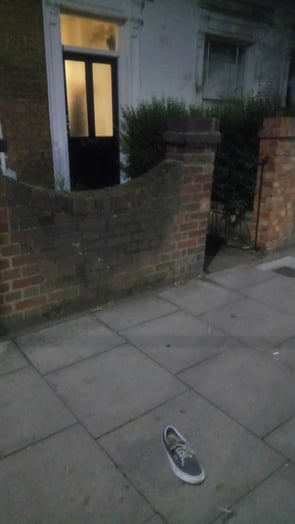
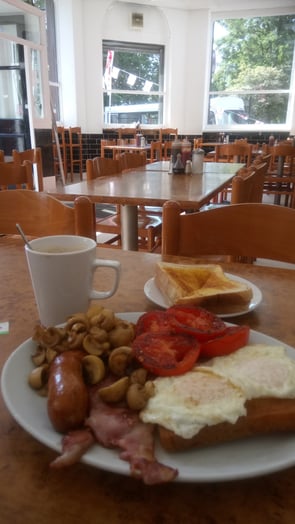


Most stressful and least stressful moments of my time in London
Have you seen the old man
In the closed down market
Kicking up the papers
With his worn out shoes?
In his eyes, you see no pride
Hand held loosely at his side
Yesterday's paper
Telling yesterday's news
So, how can you tell me you're lonely
And say for you that the sun don't shine?
Let me take you by the hand
And lead you through the streets of London
Show you something to make you change your mind.
Streets of London – Frank McTell
The Gist: London
ARRIVED: London is a global transport hub served by six international airports. If you're flying in, take care to plan for your onward transport. Heathrow is huge and can take time to navigate, and getting to your destination from any airport here will probably involve a few transfers on public transport. Don't forget to pick up your Oyster card. I arrived in Gatwick with Air Baltic from Saint Petersburg via Riga. The flight was reasonably priced but I got no sympathy at all from this airline when trying to make a revision to the booking. From the airport I reached the Tube at Victoria station via the Gatwick Express, which was quick and comfortable and relatively inexpensive with the Oyster card.
SLEPT: London is not a cheap destination for accommodation, but there are options. The city is currently full of Airbnb hosts, many of them offering rooms at reasonable prices. Keep your wits about you if sharing a home with a host or other guests and bear my story in mind, but don't be too put off by it.
DID: I think in a city on the level of London, there is no such thing as a definitive itinerary. The British Museum, Hyde Park, Sky Garden and Brick Lane were the highlights of my own visit.
LEFT: I flew out of Gatwick very cheaply with Ryanair to Dublin.

